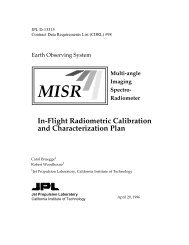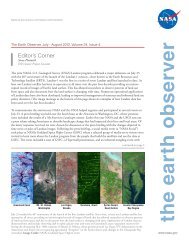AIRS Level 1B Visible/Near-Infrared Channels ATBD - NASA's Earth ...
AIRS Level 1B Visible/Near-Infrared Channels ATBD - NASA's Earth ...
AIRS Level 1B Visible/Near-Infrared Channels ATBD - NASA's Earth ...
Create successful ePaper yourself
Turn your PDF publications into a flip-book with our unique Google optimized e-Paper software.
<strong>AIRS</strong> <strong>Level</strong> 1b <strong>ATBD</strong> Part 2: Vis/<strong>Near</strong> IR <strong>Channels</strong><br />
It is necessary to determine what specific surface and atmospheric conditions will be most<br />
suitable for the <strong>AIRS</strong> and MODIS cross-calibration. We know that data acquired from desert<br />
areas in clear sky are the best data for cross-calibration. However, we need to determine how<br />
the atmospheric profiles (specifically water vapor content), change of aerosol types and<br />
concentration, thin clouds (which may not be seen by <strong>AIRS</strong> Vis/NIR channels) and<br />
randomly distributed shrubs and shadows in the target region will affect the cross-calibration<br />
results. For this purpose, we calculated <strong>AIRS</strong> and related MODIS radiances using the<br />
SBDART radiative transfer model under the following conditions:<br />
4. Surface cover: sand and vegetation.<br />
5. Atmospheric profile: tropic, sub-arctic winter, and standard US atmosphere (from McClatchey<br />
et al. 1972), with water vapor column densities 4.12, 0.85 and 4.2 g/cm 2 , respectively.<br />
6. Cloud optical thickness: 0, 1 and 2.<br />
7. Cloud layers: 0-1, 1-2, 2-3 and 3-4 km.<br />
8. Cloud droplet size effective radius: 4, 8, and 16 µm for liquid, 106 µm (with cloud top height<br />
at 10 km) for cirrus ice clouds.<br />
9. Aerosol type: rural, oceanic and urban.<br />
10. Visibility: 10, 23 and 50 km.<br />
The coefficients, ai, of the linear equations (2-7) through (2-10) are calculated under three<br />
types of conditions: (i) sand surface in clear sky, (ii) sand surface in clear sky and slightly<br />
cloudy (optical depth less than 3) and, (iii) sand and vegetated surfaces in clear sky and<br />
slightly cloudy conditions. All combinations of atmospheric conditions (atmospheric<br />
profiles, aerosols and visibilities) were included in these calculations.<br />
The linear combination of MODIS channels with respect to <strong>AIRS</strong> channels, and their fitted<br />
lines are plotted in Figs. 2.3 and 2.4 (W/m 2 is used in the plots). The coefficients of the<br />
linear equations, a i, the correlation coefficients and standard deviation are listed in Table<br />
2.2.<br />
10 November 2000 Version 2.2 21







